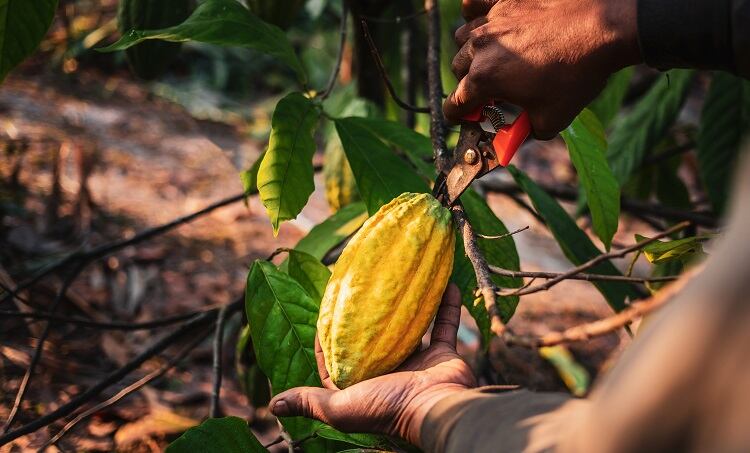Researchers have been looking at the effectiveness of red nets in deterring onion thrips from damaging crops and exploring if they could be a viable alternative to the use of chemical pesticides.
What are the benefits to using red nets in farming?
Nets have been used in the protection of crops for decades now. The net provides a physical barrier that, in many cases, insects cannot penetrate, whilst allowing sunlight, rainwater and airflow to penetrate. Nets also provide shelter from larger threats, such as birds and rabbits, which may feed on the plants.
However, the black nets and white nets, which are predominantly used, have had limited success in protecting crops against certain species of insect, such as onion thrips.
A study conducted by the University of Tokyo has found that changing the colour of the nets to red has a significant impact in protecting crops from onion thrips. Onion thrips are resistant to insecticides and can cause extensive damage to a range of crops globally, by eating them and by spreading harmful viruses.
The researchers, experimented with the effect of red, white, black, and combination-coloured nets in deterring onion thrips from eating Welsh onions. In both lab and field tests, red nets were significantly more effective in deterring onion thrips. In addition to this, the field tests showed that onion crops, which were either partially or fully covered by red netting, required 25-50% less insecticide, a type of pesticide, than was needed for a totally uncovered field.
Researchers also found that the structure of the net and the size of the holes was less significant than the colour, as Professor Masami Shimoda from the Graduate School of Agricultural and Life Sciences at the University of Tokyo explained, “we tested red nets, which had a mesh size that was larger than the insect body but was still more effective than other conventional black or white nets with a smaller mesh size. This ‘optical pest control’ relies on the nature of insect colour vision to keep pests away.”
What are onion thrips and how are they damaging to crops?
Onion thrips (Thrips tabaci) are a type of insect found across the world. They affect, and can be damaging to, many different plants but are particularly harmful to onions, leeks, cucurbits, tomatoes, sweet peppers and aubergine. Thrips cause damage to plants by piercing the cells of the surface tissue and sucking out the contents, causing the surrounding tissue to die. They can also spread harmful viruses from plant to plant. The resulting silver-grey patches on leaves indicate their presence in the crop.
Larger holes within the nets can also be beneficial to crops as they improve breathability, reducing the chance of fungal infections, as well as allowing the plants greater access to sunlight and rainwater.
The study concluded that changing agricultural nets from black or white to red could help to reduce pesticide use, and the related negative impact it can have on the environment, while supporting more sustainable and effective agricultural practices.
Red nets are currently more expensive than the use of chemical pesticides, however, they are ultimately more economical as they can be used over the course of many years. It is also likely that if more farmers across the world choose to use them then more manufactures will produce them, and the price will be reduced.
Why is it important to find eco-friendly alternatives to pesticides?
Many chemical pesticides are known to cause damage to the environment by seeping down into the soil and in finding their way into into water supplies via the water table. They can also have a negative impact on wildlife and insects, such as bees, which are essential for pollination.
According to the European Environment Agency (EEA), the use of chemical pesticides in Europe, “remains a major source of pollution, an important driver of biodiversity loss and a possible cause of negative health impacts for exposed users and citizens.” It also believes that pesticide use, “threatens key ecosystem services which help maintain food security in Europe.”
“Pesticides are poisons and, unfortunately, they can harm more than just the ‘pests’ at which they are targeted”
“Pesticides are poisons and, unfortunately, they can harm more than just the ‘pests’ at which they are targeted,” say Pesticide Action Network UK. “They are toxic, and exposure to pesticides can cause a number of health effects.”
Despite this, the European Union (EU) took the decision earlier this month to drop the agricultural reform bill, which would have cut the use of pesticides in half. This decision to abandon the bill was made due largely to strong resistance from farmers, who were concerned that reducing the amount of pesticides they were allowed to use would negatively impact their crops, putting food production at risk. In light of this, it’s important that alternatives to chemical pesticides are made available to farmers, at an affordable price, assisting them in moving away from chemical pesticide use.
Additionally, it’s becoming apparent that certain species of insect, which are harmful to crops, are becoming resistant to chemical pesticides, so it’s imperative that we find an alternative to their use, and an eco-friendly alternative is surely preferable.
Source: Advanced methods for insect nets: red-colored nets contribute to sustainable agriculture
Published online: 14 February 2024
DOI: https://www.nature.com/articles/s41598-024-52108-1
Authors: Susumu Tokumaru, Yoshiaki Tokushima, Shun Ito, Terumi Yamaguchi & Masami Shimoda





